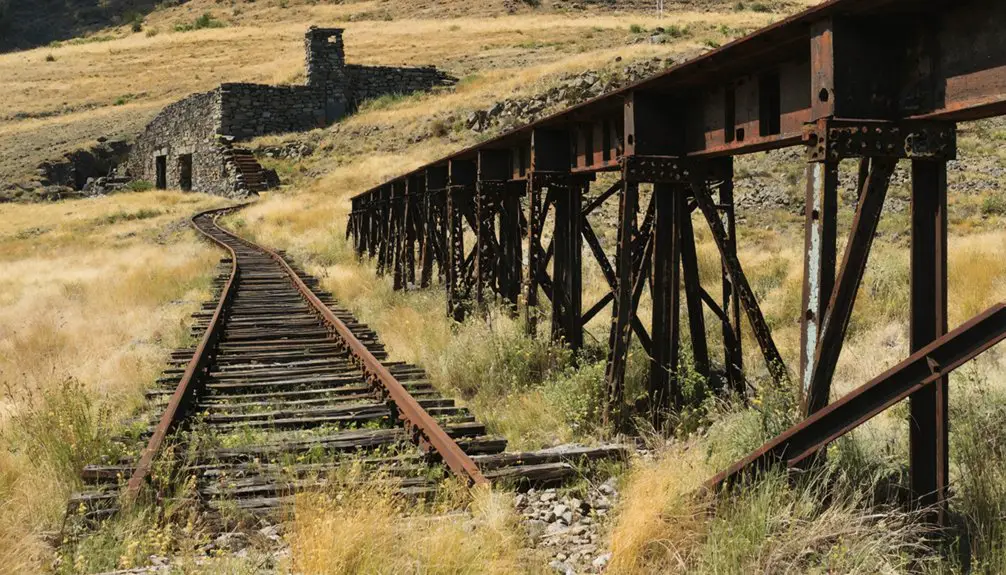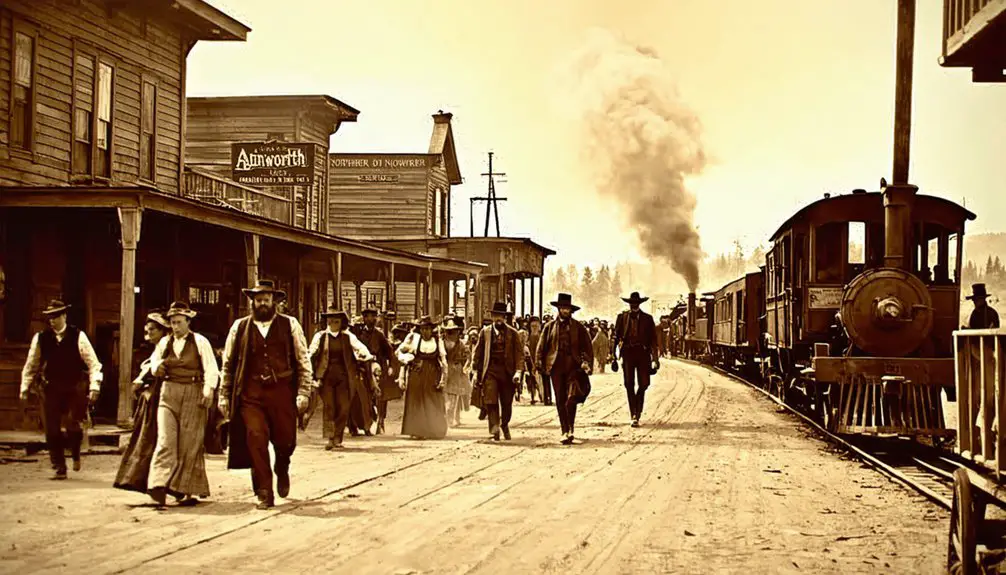You’ll find the ghost town of Ainsworth at the confluence of the Snake and Columbia Rivers, where the Northern Pacific Railroad established a major hub in 1879. During its peak in the 1880s, nearly 8,000 residents lived in this lawless frontier town, including Chinese laborers, Native Americans, and Euro-American settlers. When the railroad moved operations to Pasco in 1885, Ainsworth quickly declined. The site’s scattered foundations and artifacts tell a fascinating tale of the American West’s transformation.
Key Takeaways
- Founded in 1879 by Northern Pacific Railroad, Ainsworth grew to 8,000 residents at the confluence of Snake and Columbia Rivers.
- The town served as Franklin County’s temporary seat and major railroad hub until its decline began in 1885.
- Most buildings were dismantled and moved to Pasco after the railroad’s departure, leaving only scattered foundations beneath the surface.
- Archaeological findings reveal industrial remnants and railroad artifacts from the Snake River bridge construction era.
- The site is now characterized by sand and sagebrush, with little visible evidence of its former status as a bustling town.
The Birth of a Railroad Depot Town
When the Northern Pacific Railroad sought to establish an essential link in its transcontinental route in 1879, they founded Ainsworth at the strategic confluence of the Snake and Columbia Rivers.
You’ll find this wasn’t just any railroad town – it was a critical hub planned by U.S. Army engineer Thomas Symons to support massive railroad expansion across the American West.
In this desert plain where timber was scarce, Northern Pacific built two sawmills to produce the countless railroad ties needed for their ambitious project.
Over 5000 Chinese immigrants arrived to work in the sawmills and help lay the railroad tracks across the region.
The town’s importance grew quickly, becoming Franklin County’s temporary seat by 1883.
As a demonstration of its crucial role, Ainsworth served as the base for constructing a major bridge across the Snake River, connecting Northern Pacific’s Montana line to the Pacific Coast.
The town’s prominence was short-lived, as the 1884 bridge completion led to Ainsworth’s eventual abandonment in favor of nearby Pasco.
Wild West Days and Lawless Living
Despite its role as a vital railroad hub, Ainsworth quickly earned a reputation as one of the West’s most lawless towns, where gunfights and brawls erupted regularly through its dusty streets.
You’d find yourself in a place where frontier justice ruled – vigilante groups enforced order through hangman’s ropes and informal trials, while official lawmen were scarce.
The town’s chaotic nightlife centered around saloons, Chinese opium dens, and brothels, catering to a population of nearly 8,000, half of whom were Chinese railroad workers.
You’d witness fierce tensions between settlers and Chinese residents, who’d established their own district amid persistent discrimination. Two sawmills operated daily, providing lumber for the rapidly growing settlement.
Named after J. C. Ainsworth of the Northern Pacific Railroad, the town served as Franklin County’s first county seat in 1883.
The wild atmosphere persisted until 1885, when the railroad’s departure to Pasco triggered the town’s rapid decline, leaving behind tales of its untamed spirit.
Multicultural Workforce and Community Life
You’ll find that Ainsworth’s bustling workforce of nearly 8,000 people in the early 1880s included Chinese laborers, free Black people, Euro-American settlers, and Native Americans, all contributing to the railroad and timber industries.
Chinese merchants established their own trade shops within the town, while steamboat operations created economic connections between Native lands and industrial centers. Like the town of Govan, Ainsworth experienced brutal violence during its peak years.
Despite this productive diversity, the social fabric remained tense, with racial conflicts and labor disputes challenging daily life in the railroad boomtown. The town’s reputation for wild gun fights and brawls reflected the turbulent nature of frontier life.
Labor Camp Demographics
The labor camps of Ainsworth stood as a tribute to the region’s remarkable multicultural workforce during the late 19th century.
You’d find thousands of laborers from diverse backgrounds living in basic bunkhouses and railcar shelters, reflecting the complex labor demographics of the era. Chinese immigrants, over 5,000 strong, worked alongside Irish laborers in sawmills and railroad construction, while white workers earned up to $5 per day as teamsters. The town grew rapidly as a railroad construction camp for the Northern Pacific Railway.
Later, the region’s labor landscape evolved as Mexican American families from Texas established themselves in camps like Crewport, and African American workers settled in Pasco despite facing discrimination. The Great Depression migrants from the Midwest joined the diverse workforce, adding to the cultural tapestry of the labor camps.
These immigrant experiences shaped Ainsworth’s identity, with each group contributing to the town’s development through their distinct cultural practices and work contributions.
Cultural Trade Networks
Ainsworth’s multicultural workforce gave rise to a complex web of trade networks that shaped daily life in this bustling railroad town.
You’d find Chinese-operated trade shops, where skilled artisans worked as blacksmiths and carpenters, creating a distinct economic niche while preserving their cultural heritage. These establishments weren’t just businesses – they served as cultural hubs where immigrant workers maintained their traditions through artisan collaboration.
The town’s diverse population of 8,000 railroad workers influenced every aspect of commerce. You could visit restaurants serving various ethnic cuisines, navigate multilingual marketplaces, or witness the mixing of different business practices.
While social tensions existed, shared economic goals fostered unexpected partnerships, creating a unique trading ecosystem where cultural preservation thrived alongside industrial progress. Located at the mouth of Snake River, the town’s strategic position enhanced its role as a vital trading hub before its absorption into Pasco in 1885.
Social Life Tensions
While railroad development brought unprecedented economic opportunities to the region, social tensions simmered beneath Ainsworth’s bustling surface by 1881.
The town’s diverse workforce of nearly 8,000 laborers created a complex social tapestry marked by ethnic tensions and cultural clashes. You’d find a challenging environment where different groups struggled to maintain social cohesion amid the town’s notorious reputation for lawlessness and vice. Much like modern Washington’s ghost town attractions, Ainsworth serves as a historical reminder of the state’s complex past.
- Language barriers and cultural differences sparked frequent misunderstandings between Native Americans, European immigrants, and African American workers.
- Housing discrimination forced minorities into segregated areas with limited services, deepening social divides.
- The male-dominated, transient population hindered the development of stable community institutions, while gambling and drinking fueled recurring conflicts in public spaces.
River Commerce and Logging Operations

Located at the strategic confluence of the Snake and Columbia Rivers, river commerce flourished in Ainsworth under Captain William Polk Gray‘s pioneering steamboat operations. His vessels towed massive log booms downstream from timber-rich regions, including Nez Perce territories on the Clearwater River and forested areas in the Cascade and Blue Mountains.
You’ll find that river transportation was essential for Ainsworth’s two sawmills, which processed logs from distant forests despite the town’s barren surroundings.
The second mill, built in 1881, showcased impressive logging techniques, churning out up to 80,000 feet of rough lumber daily. This timber-processing hub relied entirely on waterborne delivery of logs, connecting multiple Native American territories to the burgeoning railroad industry that demanded lumber for ties and construction.
The Northern Pacific Railroad’s Impact
The Northern Pacific Railroad transformed the remote Snake and Columbia Rivers confluence when it established Ainsworth as a strategic depot in 1879.
You’ll find this railroad expansion created an economic transformation that turned wilderness into a bustling transportation hub, drawing up to 8,000 workers during its peak construction period.
- The railroad’s first Snake River crossing opened in 1884, replacing the stern-wheel steamer Frederick Billings that had ferried trains across.
- Over 5,000 Chinese immigrant workers lived in railcar bunkhouses, operating sawmills and laying track around the clock.
- White laborers earned $1.50 daily plus room and board, while skilled teamsters commanded up to $5 with double teams.
The Northern Pacific’s strategic decision to connect its transcontinental line through Ainsworth opened direct routes to Portland and Puget Sound, revolutionizing regional commerce.
From Boomtown to Ghost Town

You’ll find that Ainsworth’s explosive growth to nearly 8,000 residents in the early 1880s was fueled by the influx of railroad laborers, including large numbers of Chinese and Irish workers.
The town’s wild atmosphere of saloons, gunfights, and opium dens proved unsustainable once the Snake River railroad bridge was completed in 1884, eliminating the need for the construction camp.
The combination of persistent flooding, the departure of railroad operations, and the establishment of more peaceful Pasco in 1885 led to Ainsworth’s rapid abandonment, with buildings being dismantled and moved to the new settlement.
Rapid Growth and Peak
During its meteoric rise from 1879 to the mid-1880s, Ainsworth transformed from an empty desert plain into a bustling boomtown of up to 8,000 residents.
The railroad expansion brought waves of workers, while two sawmills churned out up to 80,000 feet of lumber daily, fueling an unprecedented economic boom at the confluence of the Snake and Columbia Rivers.
You would’ve witnessed:
- Steamboats hauling massive logs from distant forests to feed the hungry sawmills
- Railroad laborers, including Chinese and Irish workers, living in sprawling temporary camps
- A wild frontier atmosphere with taverns, supply stores, and lodging houses springing up virtually overnight
This strategic location made Ainsworth the heart of Franklin County’s development, earning it the county seat in 1883 during its peak years.
Factors Behind Abandonment
Despite its meteoric rise as a bustling railroad hub, Ainsworth’s transformation into a ghost town stemmed from multiple interconnected factors in the mid-1880s.
The completion of the Snake River railroad bridge in 1884 triggered an economic decline, as Northern Pacific Railroad shifted operations to the newly established Pasco Junction.
You’ll find this wasn’t just about economics – widespread community dissatisfaction with Ainsworth’s lawless reputation, marked by brawls, gunfights, and opium dens, drove settlers to seek stability elsewhere.
The Washington Territorial Legislature’s decision to move the county seat to Pasco in 1885 sealed Ainsworth’s fate.
With buildings being physically relocated and residents departing, the town’s population plummeted from 8,000 to near zero.
The harsh desert environment quickly reclaimed the abandoned settlement.
The Rise of Neighboring Pasco
While Ainsworth’s decline marked the end of one era, the rise of Pasco heralded the dawn of a new railroad town in Washington Territory.
You’ll find that Pasco’s strategic location at the confluence of three major rivers made it an ideal spot for railroad expansion and economic transformation. The Northern Pacific Railway‘s decision to relocate operations there in the 1880s sealed both cities’ fates.
- The completion of the Snake River Bridge in 1884 prompted railway workers to abandon Ainsworth for Pasco.
- By 1886, the county seat and courthouse had moved from Ainsworth to the emerging Pasco settlement.
- Pasco’s incorporation in 1891 cemented its dominance, with Virgil Bogue, a railroad engineer, naming the city after his experiences in Peru.
The city’s rapid growth through railroad development and wartime activities guaranteed its lasting prominence in the region.
Daily Life in 1880s Ainsworth

If you’d visited Ainsworth in the 1880s, you’d have found thousands of railroad workers living in crowded boarding houses and temporary shelters near the Snake and Columbia Rivers’ confluence.
After long days of grueling railroad construction, these laborers would flock to the town’s numerous saloons, including the popular White Elephant dance hall where honky-tonk music played into the night.
The rough-and-tumble nightlife featured frequent brawls and gunfights, while opium dens and houses of ill-repute operated openly in this largely lawless frontier town.
Railroad Workers’ Living Conditions
During the early 1880s, Ainsworth’s railroad workers endured stark living conditions that reflected the town’s rapid, temporary growth.
You’d find rudimentary railroad accommodations scattered across the bustling construction site, with worker hygiene taking a back seat to the urgent demands of track laying and bridge building.
- Chinese laborers packed into converted railcar bunkhouses, working continuous shifts in cramped quarters that served as both sleeping and living spaces.
- White and Irish workers often boarded themselves, paying roughly $4.50 weekly on top of their wages for basic lodging.
- Most housing structures were makeshift and temporary, designed to be dismantled or abandoned once the railroad projects finished.
The town’s infrastructure remained minimal, focusing solely on supporting the massive construction effort rather than creating permanent residences.
Saloon Culture After Dark
After long shifts on the railroad, Ainsworth’s workers found refuge in the town’s bustling saloons, where sawdust-covered floors and rough-hewn timber walls created makeshift havens of revelry.
You’d find a diverse crowd of railroad laborers, including Chinese workers, gathering around poker tables and whiskey bottles late into the night.
These log-built establishments, constructed from local timber, offered more than just drinks – they were epicenters of nighttime entertainment where news spread and deals were made.
But you’d need to watch your back; saloon violence was common, with gunfights and brawls erupting regularly.
The mix of alcohol, gambling, and minimal law enforcement created a volatile atmosphere that’d eventually drive many families to seek refuge in the more orderly settlement of Pasco.
Archaeological Findings and Historic Sites
While the original town of Ainsworth once bustled with nearly 8,000 residents, today’s archaeological site reveals little more than sand and sagebrush where this frontier railroad hub once stood.
Modern archaeological methods have identified scattered building foundations and industrial remnants beneath the surface, though most structures were dismantled and moved to nearby Pasco by the 1890s.
- Railroad artifacts, including mechanical parts and tools from the historic Snake River bridge construction, offer clues to the town’s industrial past.
- Artifact analysis has uncovered evidence of saloons, opium dens, and timber mills that once dominated the landscape.
- The site’s transformation from Native American trading ground to railroad boomtown can be traced through distinct cultural layers in the soil.
Native American Heritage at the Confluence
Long before Ainsworth claimed its brief moment in history, the confluence of the Snake and Columbia Rivers served as an essential gathering place for numerous Native American tribes.
You’ll find evidence of the area’s cultural significance in Lewis and Clark’s journals, which document their first encounters with Columbia River indigenous peoples. The Nez Perce, Yakama, Warm Springs, Cayuse, and Walla Walla tribes maintained extensive trading and kinship networks here, supported by the region’s rich natural resources.
Lewis and Clark’s journals reveal a vibrant hub of Native American life, where diverse tribes formed intricate trading networks along the Columbia.
Native connections to this strategic location span thousands of years, with tribes engaging in fishing, hunting, and active land stewardship.
However, Ainsworth’s development in the late 19th century disrupted these traditional practices, as railroads and industrial growth pushed indigenous peoples to the margins of the region’s economy and society.
Frequently Asked Questions
What Happened to the Chinese Residents After Ainsworth’s Decline?
You’ll find that Chinese migration patterns led residents to Pasco’s railroad housing, West Coast Chinatowns, and eastern Washington cities, where they sought community integration through business ownership despite discrimination.
Were There Any Notable Murders or Crimes That Occurred in Ainsworth?
While records don’t reveal specific Ainsworth murders, you’ll find the town was notorious for frequent gunfights and brawls. Most Ainsworth crimes centered on general lawlessness, gambling halls, and opium dens.
What Was the Average Cost of Living in 1880S Ainsworth?
Life’d eat up your wallet like a hungry wolf – you’d spend about $18-20 monthly on boarding ($4.50/week), while daily wages of $1.50-$5 barely covered basic housing, food, and necessities.
Did Any Famous Historical Figures Ever Visit or Stay in Ainsworth?
You won’t find records of famous visitors staying in Ainsworth beyond local figures like founder Thomas Symons and Captain William Polk Gray, who were involved in notable events during railroad construction.
What Natural Disasters or Severe Weather Events Affected Ainsworth During Its Existence?
Like a mirage in history’s desert, you won’t find records of major disasters striking Ainsworth. While dust storms and seasonal river fluctuations were likely, no documented earthquake impacts or flood damage shaped its fate.
References
- https://www.tricitiesbusinessnews.com/articles/4929-from-wild-town-to-ghost-town-the-story-of-ainsworth
- https://www.historylink.org/file/8604
- https://www.confluenceproject.org/library-post/town-vanishes-dust-bust-and-railroads-of-ainsworth/
- https://610kona.com/secrets-washington-ghost-towns/
- https://www.hmdb.org/m.asp?m=34519
- https://www.historylink.org/File/5194
- https://www.historylink.org/File/5033
- https://fchsmuseum.com/facts-history-highlights/
- https://www.historylink.org/file/7452
- https://en.wikipedia.org/wiki/John_C._Ainsworth



